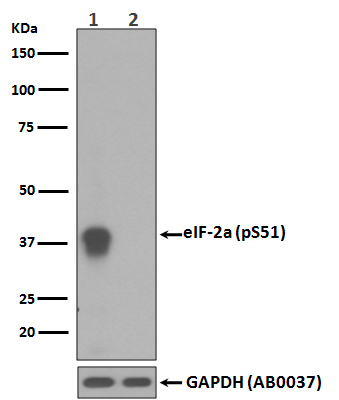Phospho-eIF2 alpha (Ser51) Antibody
Rabbit mAb
- SPECIFICATION
- CITATIONS
- PROTOCOLS
- BACKGROUND

Application
| WB, IHC, FC, ICC |
|---|---|
| Primary Accession | P05198 |
| Reactivity | Rat |
| Clonality | Monoclonal |
| Other Names | EIF-2; eIF-2-alpha; eIF-2A; eIF-2alpha; EIF2; EIF2A; EIF2S1; IF2A; |
| Isotype | Rabbit IgG |
| Host | Rabbit |
| Calculated MW | 36112 Da |
| Dilution | WB 1:500~1:2000 IHC 1:50~1:200 ICC/IF 1:50~1:200 FC 1:40 |
|---|---|
| Purification | Affinity-chromatography |
| Immunogen | A synthesized peptide derived from human Phospho-eIF2 alpha (Ser51) |
| Description | eIF2A a translation initiation factor that functions in the early steps of protein synthesis by forming a ternary complex with GTP and initiator tRNA. This complex binds to a 40s ribosomal subunit, followed by mRNA binding to form a 43S preinitiation complex. |
| Storage Condition and Buffer | Rabbit IgG in phosphate buffered saline , pH 7.4, 150mM NaCl, 0.02% sodium azide and 50% glycerol. Store at +4°C short term. Store at -20°C long term. Avoid freeze / thaw cycle. |
| Name | EIF2S1 (HGNC:3265) |
|---|---|
| Synonyms | EIF2A |
| Function | Member of the eIF2 complex that functions in the early steps of protein synthesis by forming a ternary complex with GTP and initiator tRNA (PubMed:16289705, PubMed:38340717). This complex binds to a 40S ribosomal subunit, followed by mRNA binding to form a 43S pre- initiation complex (43S PIC) (PubMed:16289705). Junction of the 60S ribosomal subunit to form the 80S initiation complex is preceded by hydrolysis of the GTP bound to eIF2 and release of an eIF2-GDP binary complex (PubMed:16289705). In order for eIF2 to recycle and catalyze another round of initiation, the GDP bound to eIF2 must exchange with GTP by way of a reaction catalyzed by eIF2B (PubMed:16289705). EIF2S1/eIF2-alpha is a key component of the integrated stress response (ISR), required for adaptation to various stress: phosphorylation by metabolic-stress sensing protein kinases (EIF2AK1/HRI, EIF2AK2/PKR, EIF2AK3/PERK and EIF2AK4/GCN2) in response to stress converts EIF2S1/eIF2-alpha in a global protein synthesis inhibitor, leading to an attenuation of cap-dependent translation, while concomitantly initiating the preferential translation of ISR-specific mRNAs, such as the transcriptional activators ATF4 and QRICH1, and hence allowing ATF4- and QRICH1-mediated reprogramming (PubMed:19131336, PubMed:33384352, PubMed:38340717). EIF2S1/eIF2-alpha also acts as an activator of mitophagy in response to mitochondrial damage: phosphorylation by EIF2AK1/HRI promotes relocalization to the mitochondrial surface, thereby triggering PRKN-independent mitophagy (PubMed:38340717). |
| Cellular Location | Cytoplasm, Stress granule {ECO:0000250|UniProtKB:Q6ZWX6}. Cytoplasm, cytosol {ECO:0000250|UniProtKB:P56286}. Mitochondrion. Note=Colocalizes with NANOS3 in the stress granules (By similarity). Relocalizes to the surface of mitochondria in response to mitochondrial damage and phosphorylation by EIF2AK1/HRI (PubMed:38340717). {ECO:0000250|UniProtKB:Q6ZWX6, ECO:0000269|PubMed:38340717} |

Thousands of laboratories across the world have published research that depended on the performance of antibodies from Abcepta to advance their research. Check out links to articles that cite our products in major peer-reviewed journals, organized by research category.
info@abcepta.com, and receive a free "I Love Antibodies" mug.
Provided below are standard protocols that you may find useful for product applications.
If you have used an Abcepta product and would like to share how it has performed, please click on the "Submit Review" button and provide the requested information. Our staff will examine and post your review and contact you if needed.
If you have any additional inquiries please email technical services at tech@abcepta.com.













 Foundational characteristics of cancer include proliferation, angiogenesis, migration, evasion of apoptosis, and cellular immortality. Find key markers for these cellular processes and antibodies to detect them.
Foundational characteristics of cancer include proliferation, angiogenesis, migration, evasion of apoptosis, and cellular immortality. Find key markers for these cellular processes and antibodies to detect them. The SUMOplot™ Analysis Program predicts and scores sumoylation sites in your protein. SUMOylation is a post-translational modification involved in various cellular processes, such as nuclear-cytosolic transport, transcriptional regulation, apoptosis, protein stability, response to stress, and progression through the cell cycle.
The SUMOplot™ Analysis Program predicts and scores sumoylation sites in your protein. SUMOylation is a post-translational modification involved in various cellular processes, such as nuclear-cytosolic transport, transcriptional regulation, apoptosis, protein stability, response to stress, and progression through the cell cycle. The Autophagy Receptor Motif Plotter predicts and scores autophagy receptor binding sites in your protein. Identifying proteins connected to this pathway is critical to understanding the role of autophagy in physiological as well as pathological processes such as development, differentiation, neurodegenerative diseases, stress, infection, and cancer.
The Autophagy Receptor Motif Plotter predicts and scores autophagy receptor binding sites in your protein. Identifying proteins connected to this pathway is critical to understanding the role of autophagy in physiological as well as pathological processes such as development, differentiation, neurodegenerative diseases, stress, infection, and cancer.


